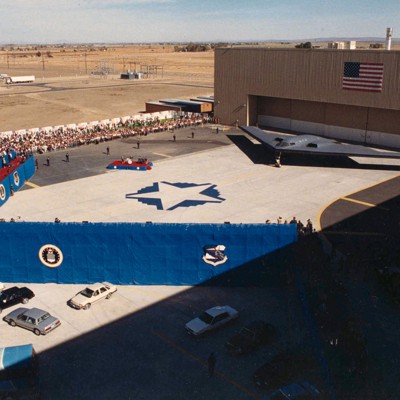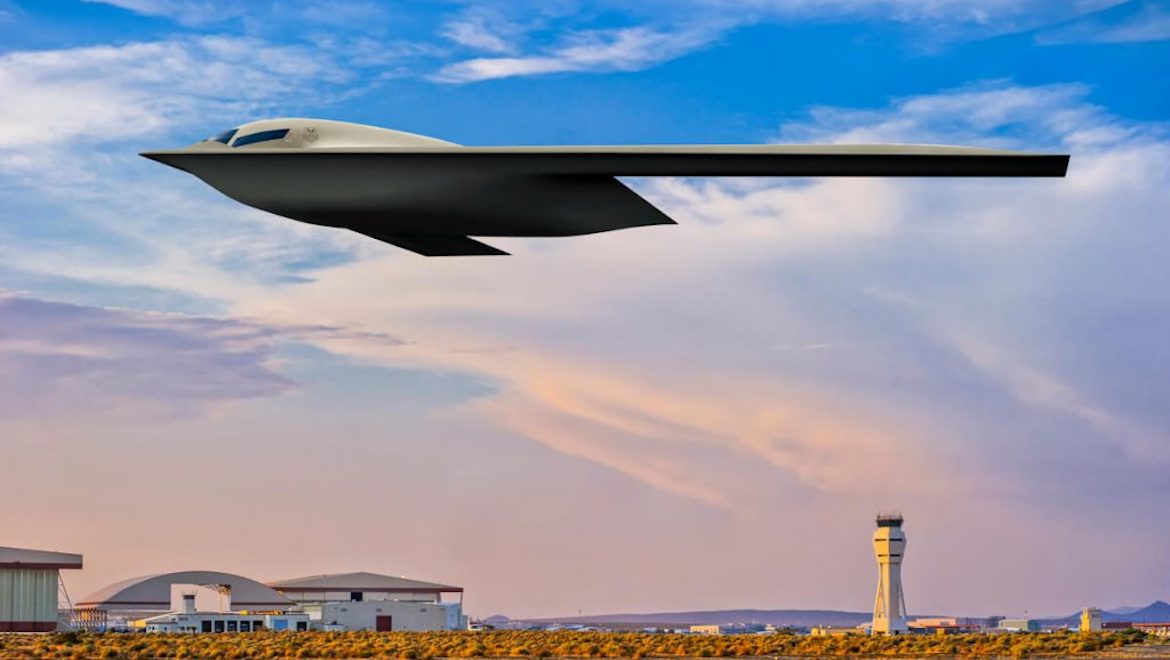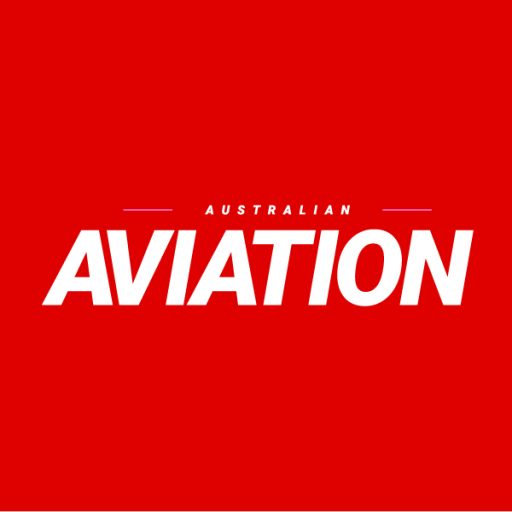I didn't say it was a sure thing. But I'd much rather be wearing a B-21 dropping glide bombs from 50k feet then in a B-52 dropping JDAM.Air defenses would like a word.That would reintroduce the possibility of short range guided weapons on heavy bombers,.
You are using an out of date browser. It may not display this or other websites correctly.
You should upgrade or use an alternative browser.
You should upgrade or use an alternative browser.
Northrop Grumman B-21 Raider (LRS-B)
- Thread starter TomS
- Start date
jsport
what do you know about surfing Major? you're from-
- Joined
- 27 July 2011
- Messages
- 7,742
- Reaction score
- 5,761

Boeing Unveils New Two-Stage Long-Range Air-To-Air Missile Concept
The new missile offering from Boeing uses two stages instead of one to increase range and lethality.
NeilChapman
Interested 3rd party
- Joined
- 14 December 2015
- Messages
- 1,317
- Reaction score
- 547

Boeing Unveils New Two-Stage Long-Range Air-To-Air Missile Concept
The new missile offering from Boeing uses two stages instead of one to increase range and lethality.www.thedrive.com
Unfortunately, I wouldn't trust Boeing with any development project. If they came with an 'in production' unit that fit my needs I'd evaluate it, but their development track record is littered with the scars of broken promises.
Dragon029
ACCESS: Top Secret
- Joined
- 17 March 2009
- Messages
- 881
- Reaction score
- 440
Lockheed writes and owns the F-35's core mission systems software; ie the sensor fusion engine, etc. Also I doubt the US government owns any IP of the F-35's EOTS; integrating a TFLIR shouldn't be difficult though.Could they use large portions of F-35 code for B-21 since they are working on Block 4 already? Perhaps someone here knows?
I'm not aware of any lens issue with DAS; for the F-35 they went from Northrop to Raytheon for Block 4 because the latter was offering a newer and better (in AFAIK every way) system; Northrop chose not to contest it, possibly for internal politics reasons or possibly because they just didn't have a decent offering ready for those SWaP + capability requirements.Let's hope they fixed the lens problem or perhaps the USAF will specify the change to Raytheon?
While I obviously can't be 100% certain, my bet would be that it's unrelated to the B-21.[Tweet]
NeilChapman
Interested 3rd party
- Joined
- 14 December 2015
- Messages
- 1,317
- Reaction score
- 547
Lockheed writes and owns the F-35's core mission systems software; ie the sensor fusion engine, etc. Also I doubt the US government owns any IP of the F-35's EOTS;
Wow, that blows me away that the customer wouldn't own the code after paying for custom integration - ridiculous actually. It's not like LM had a product sitting on the proverbial shelf. The US taxpayer underwrote all the development work did they not?
Surely this is not the case. Is there somewhere I can read up on this?
- Joined
- 3 June 2011
- Messages
- 18,349
- Reaction score
- 12,273
If LM funded it on their own dime it's theirs.Lockheed writes and owns the F-35's core mission systems software; ie the sensor fusion engine, etc. Also I doubt the US government owns any IP of the F-35's EOTS;
Wow, that blows me away that the customer wouldn't own the code after paying for custom integration - ridiculous actually. It's not like LM had a product sitting on the proverbial shelf. The US taxpayer underwrote all the development work did they not?
Surely this is not the case. Is there somewhere I can read up on this?
bring_it_on
I really should change my personal text
- Joined
- 4 July 2013
- Messages
- 3,679
- Reaction score
- 3,865
Why would you want to reuse the code, an EOTS or even the radar from the F-35? Would the B-21 even have an X band radar?
NeilChapman
Interested 3rd party
- Joined
- 14 December 2015
- Messages
- 1,317
- Reaction score
- 547
If LM funded it on their own dime it's theirs.
I guess that's my question. Is there a program report that states LM owns the code. If that's the deal the Program office made with them then God love 'em. I've seen a media report stating LM owned the logistics system ALIS but that was being transitioned to a jointly owned product called ODIN. All I see re software block development is $B's paid to LM. Nothing re LM developing code on their own dime.
Dragon029
ACCESS: Top Secret
- Joined
- 17 March 2009
- Messages
- 881
- Reaction score
- 440
It's been reported on at various points over the years; the logic back in the 90s / early 2000s was that private industry would handle everything more efficiently, so if we allow Lockheed (and NG, BAE Systems, etc) to own the intellectual property and handle things like deep level maintenance, etc, we'll save money. So while the US government did pay tens of billions for the F-35 to be developed, they essentially paid for a service (designing and testing), not a product (instead the physical aircraft is the product).Surely this is not the case. Is there somewhere I can read up on this?
In some respects they were, but it also meant that if a contractor isn't delivering as promised (as has happened plenty of times during the F-35 program), you have limited ability to re-compete contracts or aspects of the program; you can't bring in (eg) Raytheon to write sensor fusion software for the F-35 because Lockheed has the legal right to refuse to cooperate / give them access to the rest of the software. There are 'nuclear' options that could be used to obtain the IP, but you risk having the program implode or temporarily grind to a halt.
- Joined
- 21 April 2009
- Messages
- 13,762
- Reaction score
- 7,705

Air Force Chief Anticipates ‘Something Special’ for B-21 Public Debut
The Raider is still on schedule to make its first test flight with the next year, Air Force chief says.
I hope he says its been flying for a year, and no-one noticed it.....
Air Force Chief Anticipates ‘Something Special’ for B-21 Public Debut
The Raider is still on schedule to make its first test flight with the next year, Air Force chief says.www.defenseone.com
- Joined
- 21 January 2015
- Messages
- 12,167
- Reaction score
- 16,390
A windshield rendering is not often a window into the design philosophy behind a new aircraft, but that is not the case in the ultrasecretive world of the Northrop Grumman B-21 program. In fact, the oddly upward-sloping side cockpit window revealed in the latest of three official B-21 renderings is...
How A B-21 Windscreen Change Hints At Larger Design Shift | Aviation Week Network
Stealth aircraft have struggled to meet cost and schedule targets, but Northrop Grumman shows how B-21 can break the cycle.
- Joined
- 2 August 2006
- Messages
- 3,256
- Reaction score
- 1,529
It hasn't been flying, can we just stop with the mindless nonsense? You can't fly what isn't built and if it was built they would be bragging about it already. The surprise is going to be how close to being operationally ready the systems are at roll out. You'll basically be looking at a production ready aircraft before it has even flown, as opposed to an airplane prototype waiting for systems.
Yes, but if Shikaka (RQ-180) has been flying around and B-21 is a genetically close fraternal twin, then getting to that first flight is a lot less difficult then it might otherwise be.It hasn't been flying, can we just stop with the mindless nonsense? You can't fly what isn't built and if it was built they would be bragging about it already. The surprise is going to be how close to being operationally ready the systems are at roll out. You'll basically be looking at a production ready aircraft before it has even flown, as opposed to an airplane prototype waiting for systems.
Those two platforms probably have nothing more than a passing resemblance to each other. From what we know, size, engine layout, etc have nothing in common. The just both use very roughly the same geometry.
There are five B-21sin various states of assembly; it shouldn’t be long til we see one.
There are five B-21sin various states of assembly; it shouldn’t be long til we see one.
Those two platforms probably have nothing more than a passing resemblance to each other. From what we know, size, engine layout, etc have nothing in common. The just both use very roughly the same geometry.
Really, really, really, unlikely.
I did not say that. This is a picture of Shikaka (RQ-180) flying. Please describe to me the advantages the Air Force and Northrop would gain by deliberately not seeking cost savings through close commonalities in the programs.Believe what you want about the two programs. I’m confident that if the B-21 had flown the USAF would be singing it from the rooftops.

You’d have to ask them, but I’d assume that the two platforms have very different size and weights driven by the fact one is a unmanned recon platform and one is a manned intercontinental bomber.
If that is the ‘RQ-180’, and I honestly think it is, you realize the engine placement is radically different from all B-21 artwork we’ve seen, right?
If that is the ‘RQ-180’, and I honestly think it is, you realize the engine placement is radically different from all B-21 artwork we’ve seen, right?
In_A_Dream
ACCESS: Top Secret
- Joined
- 3 June 2019
- Messages
- 673
- Reaction score
- 687
I did not say that. This is a picture of Shikaka (RQ-180) flying. Please describe to me the advantages the Air Force and Northrop would gain by deliberately not seeking cost savings through close commonalities in the programs
I thought the cost savings was due to the "RQ-180" fulfilling part of the role of the LRS-B, thus allowing a less complex bomber aircraft needing to be developed. The planform commonality being an added bonus and convenience.
- Joined
- 28 January 2008
- Messages
- 1,017
- Reaction score
- 2,209
The so-called "RQ-180" I'm pretty sure is what allowed NGC to win LSR-B, capitalize on re-use and don't re-invent wheel not unless absolutely necessary. Also, NGC has changed internally and over the years with having Scaled Composites as an integral part of the company, NGC has learned a lot from Scaled in regards to lower-cost composites fabrication and rapid prototyping as an example.
Avimimus
ACCESS: Top Secret
- Joined
- 15 December 2007
- Messages
- 2,430
- Reaction score
- 911
That could mean anything. Technically, the moment they started producing the forgings for long-lead parts they started "building". Now five in final assembly would be something, but I'd bet everything I own that is not the case. Not even close.
Looks like I may have been incorrect. It would be nice if things are moving this smoothly.
Should've taken you up on that bet
Still, it is nice to see someone being able to admit they might've been mistaken (and I agreed with you anyway)
Q-nimbus
ACCESS: Confidential
- Joined
- 1 June 2020
- Messages
- 177
- Reaction score
- 204
Like what…?exactly. that's why some old stuff hidden there for 25+ years finally saw light of day again
- Joined
- 6 August 2007
- Messages
- 3,900
- Reaction score
- 6,004
The code for the bathroom at Northrop Palmdale. Hint: it’s the same as my luggage!Like what…?exactly. that's why some old stuff hidden there for 25+ years finally saw light of day again

Check Out This Super Grimy B-2 Spirit Stealth Bomber Test Article
B-2 Spirits usually look otherworldly, but every nine years they head to their birthplace for some much-needed TLC. It turns out that this unique test airframe's job is to look this way.
JG87
ACCESS: Restricted
- Joined
- 6 November 2021
- Messages
- 40
- Reaction score
- 43
We will not have until 2030-2040. Other faster options need to be considered. ASAP.Five Next-Gen US Test Bombers Currently in Production
Five Next-Gen U.S. Test Bombers Currently in Productionwww.nationaldefensemagazine.org
I like the way FK stresses USAF and USSF as key to winning the fight.
Below is an excercise I went through almost exactly two years ago guesstimating at production. I was figuring five completed by 12/21. Five may not be completed but perhaps I'm less than a year out? Certainly closer than it looked six months ago.
---
Here's a hypothetical exercise to see what B-21 procurement might look like based on the info available today.
Since we're talking integration and production of existing tech we'll assume there are mostly F-35 systems
and sensors on the new bomber. My point being that flight testing will be just that - flight and integration
testing. Not so much testing of new systems. The decade of F-35 testing will transfer to B-21.
Here are some examples of possible B-21 systems that might be reused from F-35
Dry version of F135 engine P&W listed as Sub for B-21 CNI Avionics on F-35 NG - This includes MADL and sensor fusion. B-21 talks cleanly w/F-35. AESA Radar on F-35 NG DAS on F-35 Originally NG but dropped for Raytheon starting in 2023. Let's hope they fixed the lens problem or perhaps the USAF will specify the change to Raytheon? EOTS from F-35 LM - not listed as a supplier but doesn't the USAF own the technology?
Could they use large portions of F-35 code for B-21 since they are working on Block 4 already? Perhaps someone here knows?
If the stars align, maybe flight testing will go "head-spinning-ly" quickly and they move to building operational
air vehicles within two years. With the recent news concerning production funding in '22 it leads me to believe
the USAF wants to accelerate the completion of the EMD program.
With all those caveats, maybe the next few years looks something like this.
Procurement $ in Budget Dev $ in Budget By December Air Vehicles Completed Block No. Production Lot ~6.13B spent
through 2018$2.3B 2019 AV-1 Test $3.0B 2020 AV-2 and AV-3 Test
In Q1 2021, by historical reference, we expect roll-out and ground testing to begin since 1st flight is Dec '21.
This would mean that NG keeps all AV's under wraps throughout 2020.
Procurement $ in Budget Dev $ in Budget By December Air Vehicles Completed Block No. Production Lot $3.1B FYDP 2021 AV-4 and AV-5 Pre-First Flight - Upgrade later
AV-1 or AV-2 first flight in December 2021. AV-2 through AV-5 leave for Edwards throughout 2022 as they are finished.
Block 10 build is locked down in 2021. I believe I recall seeing that the first lot is development and consists of 5 air
vehicles so the math works. USAF projecting procurement funding to begin in '22.
Production increase from 2 to 3 air vehicles for 2022
Procurement $ in Budget Dev $ in Budget By December Air Vehicles Completed Block No. Production Lot $0.2B FYDP $3.1B FYDP 2022 AV-6 through AV-8 10 LRIP-1
During 2022, B-21 begins operational training as Block 10 air vehicles become available and are
flown to Edwards throughout the year.
It's a very interesting that procurement spending is projected for '22 - '24. These are most likely
long lead time purchases but the big $$ makes me think they are planning for early completion
of the EMD contract. This $$ allows them to finish the EMD contract in FY2024 w/all 20 bombers
completed and begin production of 8 bombers per year starting in 2025.
Production increase from 3 to 5 for 2023
Procurement $ in Budget Dev $ in Budget By December Air Vehicles Completed Block No. Production Lot $2.4B FYDP $2.7B FYDP 2023 AV-9 through AV-13 10 LRIP-2/3
It's been mentioned that FRP target is 8 bombers per year. At ~$700M each that's $5.6B per year. If you
add the '22-'24 procurement $$ you get $5.9B. That provides the budget for qty 8 bombers to be
purchased in 2025 w/a budget of ~$5.9 each year after. A squadron per year.
Production increases from 5 to 7 for 2024.
Procurement $ in Budget Dev $ in Budget By December Air Vehicles Completed Block No. Production Lot $3.3B FYDP $2.3B FYDP 2024 AV-14 through AV-20 10 LRIP-3/4/5
IOC sometime in 2025 with at least 8 bombers and one trainer. With this accelerated EMD contract
completion there could be almost twice that number. This ends the EMD contract.
Production increases from 7 to 8 for 2025.
Procurement $ in Budget Dev $ in Budget By December Air Vehicles Completed Block No. Production Lot $5.9B 2025 AV-21 through AV-28 10 FRP-1 $5.9B 2026 AV-29 through AV-36 10 FRP-2 $5.9B NUC in 2027 2027 AV-37 through AV-44 20 FRP-3 $5.9B 2028 AV-45 through AV-52 20 FRP-4 $5.9B 2029 AV-53 through AV-60 20 FRP-5
In my exercise, best case scenario is 57 bombers by 2030. Six operational squadrons and a training
squadron. These are huge procurement numbers. No wonder the USAF wants to stop funding the
B-1 asap. Maybe they're speculating that the external threats will grow significantly between 2030
and 2040. In the mean time, they can save the B-1 upgrade $$ for B-21.
- Joined
- 21 April 2009
- Messages
- 13,762
- Reaction score
- 7,705

The Air Force's top civilian wants a drone wingman for the B-21 bomber - Breaking Defense
"What we want is something that can go operate with [the B-21]," said Air Force Secretary Frank Kendall.
I wonder if they are looking at a larger aircraft that would take off and land with B-21s or if they are contemplating a smaller air launched UAV that would be launched by escorting B-52s outside hostile airspace?
The Air Force's top civilian wants a drone wingman for the B-21 bomber - Breaking Defense
"What we want is something that can go operate with [the B-21]," said Air Force Secretary Frank Kendall.breakingdefense.com
Well lucky for them, whatever "Shikaka" is should be ready to slide right into that role.
The Air Force's top civilian wants a drone wingman for the B-21 bomber - Breaking Defense
"What we want is something that can go operate with [the B-21]," said Air Force Secretary Frank Kendall.breakingdefense.com
Makes sense
With the closer alignment of Australia and the US along with things such as AUKUS and the surprise (though with hindsight maybe not) of the SSN decision, maybe the idea of RAAF B-21s as mentioned numerous times over the last year or so (example below) isn't so far fetched...


 australianaviation.com.au
australianaviation.com.au

Comment: The game-changing potential of the B-21
The B-21 is expected to be the world’s most advanced, cost-effective long-range strike capability, writes Liam Garman, editor of Australian Aviation's sister title Defence Connect.
 australianaviation.com.au
australianaviation.com.au
Well lucky for them, whatever "Shikaka" is should be ready to slide right into that role.
The Air Force's top civilian wants a drone wingman for the B-21 bomber - Breaking Defense
"What we want is something that can go operate with [the B-21]," said Air Force Secretary Frank Kendall.breakingdefense.com
That seems very unlikely; I doubt the base platform is priced to be expendable, I doubt it is remotely maneuverable, and its extreme endurance would be completely unnecessary in an escort role.
- Joined
- 21 April 2009
- Messages
- 13,762
- Reaction score
- 7,705

Air Force would keep B-1 bombers until B-21s arrive, under NDAA
The NDAA would also allow the Air National Guard to retire its old RC-26 reconnaissance aircraft.
I think it would be very much on the table, if the US is willing to share nuclear technology. The B-21 is supposed to use almost exclusively 'mature' technology that likely isn't much beyond the widely exported F-35 anyway. I suspect a lot of the avionics and composite structures are at a similar level of technology and the engines are being directly brought over. Though I think the RAAF would have to wait for the USAF to replace all of its B-1s and B-2s first.With the closer alignment of Australia and the US along with things such as AUKUS and the surprise (though with hindsight maybe not) of the SSN decision, maybe the idea of RAAF B-21s as mentioned numerous times over the last year or so (example below) isn't so far fetched...

Comment: The game-changing potential of the B-21
The B-21 is expected to be the world’s most advanced, cost-effective long-range strike capability, writes Liam Garman, editor of Australian Aviation's sister title Defence Connect.australianaviation.com.au
Regarding the air force keeping B-1s until replaced by B-21: I thought that was always the plan after the retirement of the 17 hardest to maintain examples?
Why would they even need to be based together let alone take off and land together. There's no way in hell it will be air launched from the bomber. It clearly has a mission of readying the battlefield ready for the bomber in an EW sense and may even serve as a decoy playing peekaboo and spoofing the enemy away from the bomberI wonder if they are looking at a larger aircraft that would take off and land with B-21s or if they are contemplating a smaller air launched UAV that would be launched by escorting B-52s outside hostile airspace?
The Air Force's top civilian wants a drone wingman for the B-21 bomber - Breaking Defense
"What we want is something that can go operate with [the B-21]," said Air Force Secretary Frank Kendall.breakingdefense.com
Hell it could even be the same airframe albeit gutted and with unique EW components. With fuel instead of weapon bays it could have tremendous persistence
Last edited:
I’m guessing that USAF is going to continue in the direction of ‘attritable’ and thus full sized airframes like another B-21 or even RQ-180 are off the table for cost reasons, but it’s possible they go in that direction.
Similar threads
-
USAF to Retire B-1, B-2 in Early 2030s as B-21 Comes On-Line
- Started by flateric
- Replies: 323
-
-
-
-
